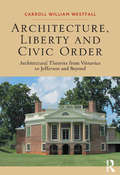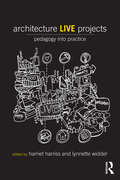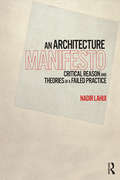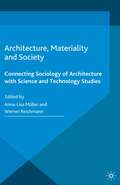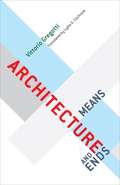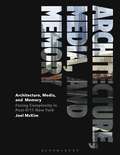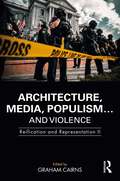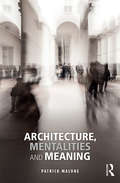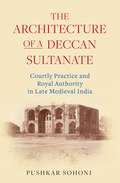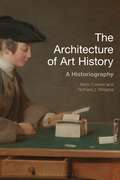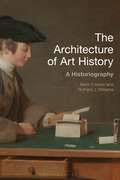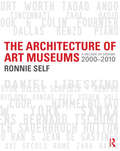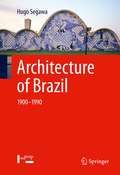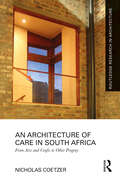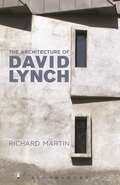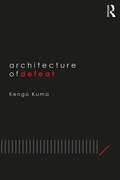- Table View
- List View
Architecture, Liberty and Civic Order: Architectural Theories from Vitruvius to Jefferson and Beyond
by Carroll William WestfallThis book brings to light central topics that are neglected in current histories and theories of architecture and urbanism. These include the role of imitation in earlier centuries and its potential role in present practice; the necessary relationship between architecture, urbanism and the rural districts; and their counterpart in the civil order that builds and uses what is built. The narrative traces two models for the practice of architecture. One follows the ancient model in which the architect renders his service to serve the interests of others; it survives and is dominant in modernism. The other, first formulated in the fifteenth century by Leon Battista Alberti, has the architect use his talent in coordination with others to contribute to the common good of a republican civil order that seeks to protect its own liberty and that of its citizens. Palladio practiced this way, and so did Thomas Jefferson when he founded a uniquely American architecture, the counterpart to the nation’s founding. This narrative gives particular emphasis to the contrasting developments in architecture on the opposite sides of the English Channel. The book presents the value for clients and architects today and in the future of drawing on history and tradition. It stresses the importance, indeed, the urgency, of restoring traditional practices so that we can build just, beautiful, and sustainable cities and rural districts that will once again assist citizens in living not only abundantly but also well as they pursue their happiness.
Architecture Live Projects: Pedagogy into Practice
by Harriet Harriss Lynnette WidderArchitecture Live Projects provides a persuasive, evidence-based advocacy for moving a particular kind of architectural learning, known as Live Projects, towards a holistic integration into current and future architectural curricula. Live Projects are work completed in the borderlands between architectural education and built environment practice; they include design/build work, community-based design, urban advocacy consulting and a host of other forms and models described by the book’s international group of authors. Because of their position, Live Projects as vehicle for simultaneously providing teaching and service has the potential to recalibrate the contesting claims that both academia and profession make to architecture. This collection of essays and case studies consolidates current discussions on theory and learning ambitions, academic best practices, negotiation with licensure and accreditation, and considerations of architectural integrity. It is an invaluable resource to current and future Live Projects advocates – whether they aim to move from pedagogy into practice or practice into pedagogy.
Architecture Live Projects: Pedagogy into Practice
by Harriet Harriss Lynnette WidderArchitecture Live Projects provides a persuasive, evidence-based advocacy for moving a particular kind of architectural learning, known as Live Projects, towards a holistic integration into current and future architectural curricula. Live Projects are work completed in the borderlands between architectural education and built environment practice; they include design/build work, community-based design, urban advocacy consulting and a host of other forms and models described by the book’s international group of authors. Because of their position, Live Projects as vehicle for simultaneously providing teaching and service has the potential to recalibrate the contesting claims that both academia and profession make to architecture. This collection of essays and case studies consolidates current discussions on theory and learning ambitions, academic best practices, negotiation with licensure and accreditation, and considerations of architectural integrity. It is an invaluable resource to current and future Live Projects advocates – whether they aim to move from pedagogy into practice or practice into pedagogy.
An Architecture Manifesto: Critical Reason and Theories of a Failed Practice
by Nadir LahijiWhat is a manifesto? In basic terms, a manifesto is ‘the invention of future for the present’. We have been oblivious to the fact that the twentieth century was the century of manifestos. It was the century of programmatic declarations, radical and avant-garde political, artistic and architectural proclamations. Manifestos came to be a genre of concise and radical-critical writings exposing the repressed contradictions in a dominant doctrine. They opened up the present to the future by denouncing the forces of the status quo and offering alternative programs. Today, this genre is a more valid, even urgent, form of writing for our time, in order to expose the dominant doctrine that has closed the future in subscribing to the ideology of the ‘end of history’. In this manifesto, Nadir Lahiji takes a leap of faith. It is a faith in Lost Causes. He asserts that today, architectonic reason has fallen into ruins. As soon as architecture leaves the limits set to it by architectonic reason, no other path is open to it but the path to aestheticism. This is the wrong path contemporary architecture has taken. In its reduction to a pure aesthetic object, architecture negatively affects the human sensorium. Capitalist consumer society creates desires by generating ‘surplus-enjoyment’ for capitalist profit and contemporary architecture has become an instrument in generating this ‘surplus-enjoyment’, with fatal consequences. This manifesto is thus both a critique and a work of theory. It is a siren, alarm, klaxon to the current status quo within architectural discourse and a timely response to the conditions of architecture today.
An Architecture Manifesto: Critical Reason and Theories of a Failed Practice
by Nadir LahijiWhat is a manifesto? In basic terms, a manifesto is ‘the invention of future for the present’. We have been oblivious to the fact that the twentieth century was the century of manifestos. It was the century of programmatic declarations, radical and avant-garde political, artistic and architectural proclamations. Manifestos came to be a genre of concise and radical-critical writings exposing the repressed contradictions in a dominant doctrine. They opened up the present to the future by denouncing the forces of the status quo and offering alternative programs. Today, this genre is a more valid, even urgent, form of writing for our time, in order to expose the dominant doctrine that has closed the future in subscribing to the ideology of the ‘end of history’. In this manifesto, Nadir Lahiji takes a leap of faith. It is a faith in Lost Causes. He asserts that today, architectonic reason has fallen into ruins. As soon as architecture leaves the limits set to it by architectonic reason, no other path is open to it but the path to aestheticism. This is the wrong path contemporary architecture has taken. In its reduction to a pure aesthetic object, architecture negatively affects the human sensorium. Capitalist consumer society creates desires by generating ‘surplus-enjoyment’ for capitalist profit and contemporary architecture has become an instrument in generating this ‘surplus-enjoyment’, with fatal consequences. This manifesto is thus both a critique and a work of theory. It is a siren, alarm, klaxon to the current status quo within architectural discourse and a timely response to the conditions of architecture today.
Architecture, Materiality and Society: Connecting Sociology of Architecture with Science and Technology Studies
by Anna-Lisa Müller Werner ReichmannThis book examines the extent to which the insights of STS can be used to analyse the role of architecture in and for social life. The contributions examine the question of whether architecture and thus materiality as a whole has agency. The book also proposes a theoretical and methodological approach on how to research architecture's agency.
Architecture, Means and Ends
by Vittorio GregottiVittorio Gregotti—the architect of Barcelona’s Olympic Stadium, Milan’s Arcimboldi Opera Theater, and Lisbon’s Centro Cultural de Belém, among many other noted constructions—is not only a designer of international repute but an acclaimed theorist and critic. Architecture, Means and Ends is his practical and imaginative reflection on the role of the technical aspects of architectural design, both as part of the larger process of innovation and in relation to the mythic opposition between vision and construction. Interweaving the seemingly irreconcilable concerns of aesthetics, meaning, and construction, Architecture, Means and Ends reflects Gregotti’s overarching claim that buildings always have a symbolic, cultural content. In this book, he argues that by making symbolic expression a primary objective in the design of a project, the designer will produce a practical aesthetic as well as an ethical solution. Architecture, Means and Ends embraces that philosophy and will appeal to those, like Gregotti, working at the intersections of the history of design, art criticism, and architectural theory.
Architecture, Media, and Memory: Facing Complexity in Post-9/11 New York
by Joel McKimArchitecture, Media and Memory examines the wide range of urban sites impacted by September 11 and its aftermath – from the spontaneous memorials that emerged in Union Square in the hours after the attacks, to the reconstruction at Ground Zero, to vast ongoing landscape urbanism projects beyond.Yet this is not simply a book about post-9/11 architecture. It instead presents 9/11 as a multifaceted case study to explore a discourse on memory and its representation in the built environment. It argues that the reconstruction of New York must be considered in relation to larger issues of urban development, ongoing global conflicts, the rise of digital media, and the culture, philosophy and aesthetics of memory. It shows how understanding architecture in New York post-9/11 requires bringing memory into contact with a complex array of political, economic and social forces.Demonstrating an ability to explain complex philosophical ideas in language that will be accessible to students and researchers alike in architecture, urban studies, cultural studies and memory studies, this book serves as a thought-provoking account of the intertwining of contemporary architecture, media and memory.
Architecture, Media, and Memory: Facing Complexity in Post-9/11 New York
by Joel McKimArchitecture, Media and Memory examines the wide range of urban sites impacted by September 11 and its aftermath – from the spontaneous memorials that emerged in Union Square in the hours after the attacks, to the reconstruction at Ground Zero, to vast ongoing landscape urbanism projects beyond.Yet this is not simply a book about post-9/11 architecture. It instead presents 9/11 as a multifaceted case study to explore a discourse on memory and its representation in the built environment. It argues that the reconstruction of New York must be considered in relation to larger issues of urban development, ongoing global conflicts, the rise of digital media, and the culture, philosophy and aesthetics of memory. It shows how understanding architecture in New York post-9/11 requires bringing memory into contact with a complex array of political, economic and social forces.Demonstrating an ability to explain complex philosophical ideas in language that will be accessible to students and researchers alike in architecture, urban studies, cultural studies and memory studies, this book serves as a thought-provoking account of the intertwining of contemporary architecture, media and memory.
Architecture, Media, Populism… and Violence: Reification and Representation II
by Graham CairnsThe ‘Storming of the Capitol’ was, for many, the culminating media performance of the four-year presidency of Donald Trump. His presidency and its ‘final act’, bore all the hallmarks of a 21st century form of populism and media-politico spectacle that may yet come to dominate the political scene in the US, and worldwide, for years to come. The questions that such events raise are complex, varied and operative across a multitude of disciplines. This book engages with these vexed questions in the broad fields of politics and media, but does so, uniquely, through the prism of architecture. This book does not, however, limit its view to the recent events in Washington DC or the United States. Rather, it seeks to use those events as the starting point for a critique of architecture in the tapestry of mediated forms of protest and ‘political action’ more generally. Each chapter draws on case studies from across timeframes and across nations. The book sharpens our critique of the relationship between direct political action, its media representation and the role it assigns to architecture – as played out globally in the age of mass media. In doing so, it opens up broader debates about the past, present and future roles of architecture as a political tool in the context of international political systems now dominated by changing and unpredictable uses of media, and characterised by an increasingly volatile and at times violent form of political activism. It is essential reading for any student or researcher engaging with these questions.
Architecture, Media, Populism… and Violence: Reification and Representation II
by Graham CairnsThe ‘Storming of the Capitol’ was, for many, the culminating media performance of the four-year presidency of Donald Trump. His presidency and its ‘final act’, bore all the hallmarks of a 21st century form of populism and media-politico spectacle that may yet come to dominate the political scene in the US, and worldwide, for years to come. The questions that such events raise are complex, varied and operative across a multitude of disciplines. This book engages with these vexed questions in the broad fields of politics and media, but does so, uniquely, through the prism of architecture. This book does not, however, limit its view to the recent events in Washington DC or the United States. Rather, it seeks to use those events as the starting point for a critique of architecture in the tapestry of mediated forms of protest and ‘political action’ more generally. Each chapter draws on case studies from across timeframes and across nations. The book sharpens our critique of the relationship between direct political action, its media representation and the role it assigns to architecture – as played out globally in the age of mass media. In doing so, it opens up broader debates about the past, present and future roles of architecture as a political tool in the context of international political systems now dominated by changing and unpredictable uses of media, and characterised by an increasingly volatile and at times violent form of political activism. It is essential reading for any student or researcher engaging with these questions.
Architecture, Mentalities and Meaning
by Patrick MaloneIn order to function, architectural theory and practice must be shaped to suit current cultural, economic, and political forces. Thus, architecture embodies reductive logic that conditions the treatment of human and social processes – which raises the question of how to define objectivity for architectural mentalities that must conform to a set of immediate conditions. This book focuses on meaning, and on the physical and mental processes that define life in built environments. The potential to draw knowledge from aesthetics, psychology, political economy, philosophy, geography, and sociology is offset by the fact that architectural logic is inevitably reductive, cultural, socio-economic, and political. However, despite the duty to conform, it is argued that the treatment of human processes, and the understanding of architectural mentalities, can benefit from interdisciplinary linkages, small freedoms, and cracks in a system of imperatives that can yield the means of greater objectivity. This is valuable reading for students and researchers interested in architectural theory as a working reality, and in the relationships between architecture and other fields.
Architecture, Mentalities and Meaning
by Patrick MaloneIn order to function, architectural theory and practice must be shaped to suit current cultural, economic, and political forces. Thus, architecture embodies reductive logic that conditions the treatment of human and social processes – which raises the question of how to define objectivity for architectural mentalities that must conform to a set of immediate conditions. This book focuses on meaning, and on the physical and mental processes that define life in built environments. The potential to draw knowledge from aesthetics, psychology, political economy, philosophy, geography, and sociology is offset by the fact that architectural logic is inevitably reductive, cultural, socio-economic, and political. However, despite the duty to conform, it is argued that the treatment of human processes, and the understanding of architectural mentalities, can benefit from interdisciplinary linkages, small freedoms, and cracks in a system of imperatives that can yield the means of greater objectivity. This is valuable reading for students and researchers interested in architectural theory as a working reality, and in the relationships between architecture and other fields.
The Architecture of a Deccan Sultanate: Courtly Practice and Royal Authority in Late Medieval India (Library Of Islamic South Asia Ser.)
by Pushkar SohoniThe Deccan sultans left a grand architectural and artistic legacy. They commissioned palaces, mosques, gardens and tombs as well as decorative paintings and coins. Of these sultanates, the Nizam Shahs (r. 1490-1636) were particularly significant, being one of the first to emerge from the crumbling edifice of the Bahmani Empire (c. 1347-1527). Yet their rich material record remains largely unstudied in the scholarly literature, obscuring their cultural and historical importance. This book provides the first analysis of the architecture of the Nizam Shahs. Pushkar Sohoni examines the critical relationship between architectural production, courtly practice and royal authority in a period when the aspirations and politics of the kingdom were articulated through architectural expression. Based on new primary research from key sites including the urban settlements of Ahmadnagar, Daulatabad, Aurangabad, Junnar and the port city of Chaul, Sohoni sheds light on broader Islamicate ideas of kingship and shows how this was embodied by material artefacts such as buildings and sites, paintings, gardens, guns and coins.As well as offering a vivid depiction of sixteenth-century South Asia, this book revises understanding of the cultural importance of the Nizam Shahs and their place in the Indian Ocean world. It will be a vital primary resource for scholars researching the history of the medieval and early modern Deccan and relevant for those working in Art History, Islamic Studies, South Asian Studies and Archaeology.
The Architecture of Art History: A Historiography (History of Art and Architecture)
by Mark Crinson Richard J. WilliamsWhat is the place of architecture in the history of art? Why has it been at times central to the discipline, and at other times seemingly so marginal? What is its place now? Many disciplines have a stake in the history of architecture – sociology, anthropology, human geography, to name a few. This book deals with perhaps the most influential tradition of all – art history – examining how the relation between the disciplines of art history and architectural history has waxed and waned over the last one hundred and fifty years. In this highly original study, Mark Crinson and Richard J. Williams point to a decline in the importance attributed to the role of architecture in art history over the last century – which has happened without crisis or self-reflection. The book explores the problem in relation to key art historical approaches, from formalism, to feminism, to the social history of art, and in key institutions from the Museum of Modern Art, to the journal October. Among the key thinkers explored are Banham, Baxandall, Giedion, Panofsky, Pevsner, Pollock, Riegl, Rowe, Steinberg, Wittkower and Wölfflin. The book will provoke debate on the historiography and present state of the discipline of art history, and it makes a powerful case for the reconsideration of architecture.
The Architecture of Art History: A Historiography (History of Art and Architecture)
by Mark Crinson Richard J. WilliamsWhat is the place of architecture in the history of art? Why has it been at times central to the discipline, and at other times seemingly so marginal? What is its place now? Many disciplines have a stake in the history of architecture – sociology, anthropology, human geography, to name a few. This book deals with perhaps the most influential tradition of all – art history – examining how the relation between the disciplines of art history and architectural history has waxed and waned over the last one hundred and fifty years. In this highly original study, Mark Crinson and Richard J. Williams point to a decline in the importance attributed to the role of architecture in art history over the last century – which has happened without crisis or self-reflection. The book explores the problem in relation to key art historical approaches, from formalism, to feminism, to the social history of art, and in key institutions from the Museum of Modern Art, to the journal October. Among the key thinkers explored are Banham, Baxandall, Giedion, Panofsky, Pevsner, Pollock, Riegl, Rowe, Steinberg, Wittkower and Wölfflin. The book will provoke debate on the historiography and present state of the discipline of art history, and it makes a powerful case for the reconsideration of architecture.
The Architecture of Art Museums: A Decade of Design: 2000 - 2010
by Ronnie SelfAs a building type, art museums are unparalleled for the opportunities they provide for architectural investigation and experimentation. They are frequently key components of urban revitalization and often push the limits of building technology. Art museums are places of pleasure, education and contemplation. They are remarkable by their prominence and sheer quantity, and their lessons are useful for all architects and for all building types. This book provides explicit and comprehensive coverage of the most important museums built in the first ten years of the 21st Century in the United States and Europe. By dissecting and analyzing each case, Ronnie Self allows the reader to get under the skin of each design and fully understand the process behind these remarkable buildings. Richly designed with full technical illustrations and sections the book includes the work of Tadao Ando, Zaha Hadid, Peter Cook & Colin Fournier, Renzo Piano, Yoshi Taniguchi, Herzog & de Meuron, Jean Nouvel, SANAA, Daniel Libeskind, Diller Scofidio & Renfro, Steven Holl, Coop Himmelb(l)au, Bernard Tschumi, Sauerbruch Hutton, and Shigeru Ban & Jean de Gastines. Together these diverse projects provide a catalogue of design solutions for the contemporary museum and a snapshot of current architectural thought and culture. One of few books on this subject written by an architect, Self’s analysis thoroughly and critically appraises each project from multiple aspects and crucially takes the reader from concept to building. This is an essential book for any professional engaged in designing a museum.
The Architecture of Art Museums: A Decade of Design: 2000 - 2010
by Ronnie SelfAs a building type, art museums are unparalleled for the opportunities they provide for architectural investigation and experimentation. They are frequently key components of urban revitalization and often push the limits of building technology. Art museums are places of pleasure, education and contemplation. They are remarkable by their prominence and sheer quantity, and their lessons are useful for all architects and for all building types. This book provides explicit and comprehensive coverage of the most important museums built in the first ten years of the 21st Century in the United States and Europe. By dissecting and analyzing each case, Ronnie Self allows the reader to get under the skin of each design and fully understand the process behind these remarkable buildings. Richly designed with full technical illustrations and sections the book includes the work of Tadao Ando, Zaha Hadid, Peter Cook & Colin Fournier, Renzo Piano, Yoshi Taniguchi, Herzog & de Meuron, Jean Nouvel, SANAA, Daniel Libeskind, Diller Scofidio & Renfro, Steven Holl, Coop Himmelb(l)au, Bernard Tschumi, Sauerbruch Hutton, and Shigeru Ban & Jean de Gastines. Together these diverse projects provide a catalogue of design solutions for the contemporary museum and a snapshot of current architectural thought and culture. One of few books on this subject written by an architect, Self’s analysis thoroughly and critically appraises each project from multiple aspects and crucially takes the reader from concept to building. This is an essential book for any professional engaged in designing a museum.
Architecture of Brazil: 1900-1990
by Hugo SegawaArchitecture of Brazil: 1900-1990 examines the processes that underpin modern Brazilian architecture under various influences and characterizes different understandings of modernity, evident in the chapter topics of this book. Accordingly, the author does not give overall preference to particular architects nor works, with the exception of a few specific works and architects, including Warchavchik, Niemeyer, Lucio Costa, and Vilanova Artigas.
An Architecture of Care in South Africa: From Arts and Crafts to Other Progeny (Routledge Research in Architecture)
by Nicholas CoetzerArchitects care. It is foundational and germane to the discipline and practice of architecture. This book charts the way the Arts and Crafts Movement established the moral ethos of ‘an architecture of care’ that not only remains embedded in current discourse and practice but also that is being given a more vocal presence in our climate-crisis and social justice world. By way of ‘genealogical strands’ the book charts the origin of ‘architecture of care’ ideas in the Arts and Crafts Movement and their impact on the ‘other progeny’ architectural projects in South Africa over the past hundred years. These range from the translation of inglenooks into an armature architecture of ‘Dignified Places’ in Cape Town’s townships to the ethos of ‘upliftment’ and care that translates from Octavia Hill through to ‘correcting’ building regulations and eventually finding a less moralising and more transformative impact in the ‘Hostels to Homes’ project. The birth of design through context and climate in the Arts and Crafts Movement is demonstrated by the shift in South African houses from boxy cottages to solar- and nature-oriented ribbon plans as demonstrated through the work of Helmut Stauch and Norman Eaton. The dislocation of Arts and Crafts ideas to the Cape also demonstrated a limit to the valorising of vernacular architecture and its ‘against-globalization’ building materials whereby English architects promoted Cape Dutch settler architecture and denigrated African vernacular architecture. As a final ‘genealogical strand,’ the book demonstrates the coherence of moral instrumentality with the animism and affects potential of handmade buildings. Written for academics, students and researchers interested in architectural history, it is an eye-opening investigation into the role of architecture in society.
An Architecture of Care in South Africa: From Arts and Crafts to Other Progeny (Routledge Research in Architecture)
by Nicholas CoetzerArchitects care. It is foundational and germane to the discipline and practice of architecture. This book charts the way the Arts and Crafts Movement established the moral ethos of ‘an architecture of care’ that not only remains embedded in current discourse and practice but also that is being given a more vocal presence in our climate-crisis and social justice world. By way of ‘genealogical strands’ the book charts the origin of ‘architecture of care’ ideas in the Arts and Crafts Movement and their impact on the ‘other progeny’ architectural projects in South Africa over the past hundred years. These range from the translation of inglenooks into an armature architecture of ‘Dignified Places’ in Cape Town’s townships to the ethos of ‘upliftment’ and care that translates from Octavia Hill through to ‘correcting’ building regulations and eventually finding a less moralising and more transformative impact in the ‘Hostels to Homes’ project. The birth of design through context and climate in the Arts and Crafts Movement is demonstrated by the shift in South African houses from boxy cottages to solar- and nature-oriented ribbon plans as demonstrated through the work of Helmut Stauch and Norman Eaton. The dislocation of Arts and Crafts ideas to the Cape also demonstrated a limit to the valorising of vernacular architecture and its ‘against-globalization’ building materials whereby English architects promoted Cape Dutch settler architecture and denigrated African vernacular architecture. As a final ‘genealogical strand,’ the book demonstrates the coherence of moral instrumentality with the animism and affects potential of handmade buildings. Written for academics, students and researchers interested in architectural history, it is an eye-opening investigation into the role of architecture in society.
The Architecture of David Lynch
by Richard MartinFrom the Red Room in Twin Peaks to Club Silencio in Mulholland Drive, the work of David Lynch contains some of the most remarkable spaces in contemporary culture. Richard Martin's compelling study is the first sustained critical assessment of the role architecture and design play in Lynch's films. Martin combines original research at Lynchian locations in Los Angeles, London and Lódz with insights from architects including Adolf Loos, Le Corbusier and Jean Nouvel and urban theorists such as Jane Jacobs and Edward Soja. In analyzing the towns, cities, homes, roads and stages found in Lynch's work, Martin not only reveals their central importance for understanding this controversial and distinctive film-maker,but also suggests how Lynch's films can provide a deeper understanding of the places and spaces in which we live.
The Architecture of David Lynch
by Richard MartinFrom the Red Room in Twin Peaks to Club Silencio in Mulholland Drive, the work of David Lynch contains some of the most remarkable spaces in contemporary culture. Richard Martin's compelling study is the first sustained critical assessment of the role architecture and design play in Lynch's films. Martin combines original research at Lynchian locations in Los Angeles, London and Lódz with insights from architects including Adolf Loos, Le Corbusier and Jean Nouvel and urban theorists such as Jane Jacobs and Edward Soja. In analyzing the towns, cities, homes, roads and stages found in Lynch's work, Martin not only reveals their central importance for understanding this controversial and distinctive film-maker,but also suggests how Lynch's films can provide a deeper understanding of the places and spaces in which we live.
Architecture of Defeat
by Kengo KumaKengo Kuma, one of Japan’s leading architects, has been combining professional practice and academia for most of his career. In addition to creating many internationally recognized buildings all over the world, he has written extensively about the history and theory of architecture. Like his built work, his writings also reflect his profound personal philosophy. Architecture of Defeat is no exception. Now available in English for the first time, the book explores events and architectural trends in the twentieth and twenty-first centuries in both Japan and beyond. It brings together a collection of essays which Kuma wrote after disasters such as the destruction of the World Trade Center in New York City on 9/11 and the earthquake and tsunami that obliterated much of the built landscape on Japan’s northern shore in a matter of minutes in 2011. Asking if we have been building in a manner that is too self-confident or arrogant, he examines architecture’s intrinsic—and often problematic—relationship to the powerful forces of contemporary politics, economics, consumerism, and technology, as well as its vital ties to society. Despite the title, Architecture of Defeat is an optimistic and hopeful book. Rather than anticipating the demise of architecture, Kuma envisages a different mode of conceiving architecture: guided and shaped by more modesty and with greater respect for the forces of our natural world. Beautifully designed and illustrated, this is a fascinating insight into the thinking of one of the world’s most influential architects.
Architecture of Defeat
by Kengo KumaKengo Kuma, one of Japan’s leading architects, has been combining professional practice and academia for most of his career. In addition to creating many internationally recognized buildings all over the world, he has written extensively about the history and theory of architecture. Like his built work, his writings also reflect his profound personal philosophy. Architecture of Defeat is no exception. Now available in English for the first time, the book explores events and architectural trends in the twentieth and twenty-first centuries in both Japan and beyond. It brings together a collection of essays which Kuma wrote after disasters such as the destruction of the World Trade Center in New York City on 9/11 and the earthquake and tsunami that obliterated much of the built landscape on Japan’s northern shore in a matter of minutes in 2011. Asking if we have been building in a manner that is too self-confident or arrogant, he examines architecture’s intrinsic—and often problematic—relationship to the powerful forces of contemporary politics, economics, consumerism, and technology, as well as its vital ties to society. Despite the title, Architecture of Defeat is an optimistic and hopeful book. Rather than anticipating the demise of architecture, Kuma envisages a different mode of conceiving architecture: guided and shaped by more modesty and with greater respect for the forces of our natural world. Beautifully designed and illustrated, this is a fascinating insight into the thinking of one of the world’s most influential architects.
